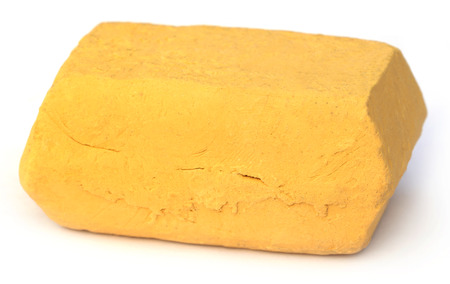Multani Mitti
 Fuller's earth is any of various clays used as an absorbent, filter, or bleaching agent. Products labeled fuller's earth typically consist of palygorskite (also known as attapulgite) or bentonite.[1] Primary modern uses include as absorbents for oil, grease, and animal waste (cat litter), and as a carrier for pesticides and fertilizers. Minor uses include filtering, clarifying, and decolorizing;[1][2] as an active and inactive ingredient in beauty products; and as a filler in paint, plaster, adhesives, and pharmaceuticals.[1] It also has a number of uses in the film industry and on stage.
Fuller's earth is any of various clays used as an absorbent, filter, or bleaching agent. Products labeled fuller's earth typically consist of palygorskite (also known as attapulgite) or bentonite.[1] Primary modern uses include as absorbents for oil, grease, and animal waste (cat litter), and as a carrier for pesticides and fertilizers. Minor uses include filtering, clarifying, and decolorizing;[1][2] as an active and inactive ingredient in beauty products; and as a filler in paint, plaster, adhesives, and pharmaceuticals.[1] It also has a number of uses in the film industry and on stage.
The English name reflects the historical use of the material for fulling (cleaning and shrinking) wool, by textile workers known as fullers.[1][2][3] In past centuries, fullers kneaded fuller's earth and water into woollen cloth to absorb lanolin, oils, and other greasy impurities as part of the cloth finishing process.
The original spelling was without an apostrophe, but the apostrophe became more common in the 19th century, both before or after the s. Fuller's earth is the most common spelling today, but both fullers earth and fullers' earth remain in wide use.[4]
Fuller's earth is also known by the following other names:
Fuller's earth consists primarily of hydrous aluminum silicates (clay minerals) of varying composition.[1] Common components are montmorillonite, kaolinite, and attapulgite. Small amounts of other minerals may be present in fuller's earth deposits, including calcite, dolomite, and quartz. In some localities fuller's earth refers to calcium bentonite, which is altered volcanic ash composed mostly of montmorillonite.[2][7]
In 2005, the United States was the largest producer of fuller's earth with an almost 70% world share followed at a distance by Japan and Mexico. In the United States fuller's earth is typically derived from deposits of volcanic ash of Cretaceous age and younger (glacial clays do not form fuller's earth).[1][5] Fuller's earth deposits have been mined in 24 states.[1] The first discovery of fuller's earth in the United States was near Quincy, Florida, in 1893; previously it was imported from England. In 1939 mines near Quincy produced half the U.S. production.[8]
In the United Kingdom, fuller's earth occurs mainly in England. It has been mined in the Lower Greensand Group and the Vale of White Horse, Oxfordshire. The Combe Hay Mine was a fuller's earth mine operating to the south of Bath, Somerset, until 1979.[9] Other sites south of Bath included Frome, Lonsdale, Englishcombe, Tucking Mill, and Duncorn Hill.[10] Although these sites had been used since Roman times, William Smith developed new methods for the identification of deposits of fuller's earth to the south of Bath.[11] Other English sources include a mine near Redhill, Surrey (worked until 2000), and Woburn, Bedfordshire, where production ceased in 2004.[12]
Hills, cliffs, and slopes that contain fuller's earth can be unstable, since this material can be thixotropic when saturated by heavy rainfall.
Fulling is an important step in the production of woolen garments, and can be traced back to ancient times. Cuneiform texts from Mesopotamia mention a raw material, im-bab-bár (Akkadian: 𒅎𒌓, gaṣṣu: 'gypsum, plaster'), literally "white earth", which was delivered to fullers for the finishing of cloth.[13] There are several Biblical references to fulling (2 Kings 18:17; Isaiah 7:3 and 36:2; Malachi 3:2; Mark 9:3), but the materials used to whiten the fabric are not specified. Pliny the Elder mentions several types of fuller's earth (creta fullonia in Latin) from a variety of locations, each with different properties and therefore different uses.
The first references to fulling mills are from Persia, and by the time of the Crusades in the late eleventh century, fulling mills were active throughout the medieval world.[14]
The use of fuller's earth across the Indian subcontinent dates back to at least 1879.[15] While its household use and transportation by local carts in the Sindh region of Pakistan predates the 1800s, export by rail was first recorded in 1929 in British India.
The value of fuller's earth is a plot point in the Sherlock Holmes story "The Adventure of the Engineer's Thumb" (1892). In the story, an engineer is paid an outlandish sum to repair a hydraulic press, accepting his client's explanation that the potential profit from fuller's earth warrants both the expense and total secrecy. The adventure is set in 1889, implying that fuller's earth was then well-known as a lucrative commodity, "only found in one or two places in England".[16]
Fuller's earth is utilized in a number of industries.[1][5] Most important modern applications make use of the minerals' natural absorbent properties in products sold as absorbents or filters.